
Brand identity is one of the most valuable assets of any business. On the surface, brand identity consists of the name, tagline, logo, typeface, and color palette. But there is more to your brand than these physical traits.
In fact, all forms of messaging run central to your brand and should reflect the value and perception your company is trying to bring to the market. A brand needs to be carefully crafted to represent your business authentically.
Why Is a Brand Refresh Important?
Think about some of the best brand identities in the market. What names come to mind?
According to Interbrands Best Global Brands 2017, the Top 10 Global Brands are Apple, Google, Microsoft, Coca-Cola, Amazon, Samsung, Toyota, Facebook, Mercedes, and IBM.
These iconic brands, with their well-established identities and household awareness, did not start out that way. Over time, these companies have painstakingly built up their brand identity.
Customer needs constantly change, especially in the multifamily property industry as Gen Z renters enter the buyer’s market. As such, your business and its brand identity should be flexible to meet customers’ new and old needs. As your business grows and adapts to the ever-changing market, so too should your brand reflect fresh and up-to-date messaging, imagery, website presence, and social media, all with a clear vision.
Auditing and Assessing Your Brand
As you consider a brand refresh, the first step is to audit and assess your brand and marketing materials. Do they speak directly to the customers you want to reach? Is your key message accurately reflected? Do they represent the lifestyle potential renters can expect?
When auditing for a refresh, it is important to note that your brand does not need to be scrapped. In fact, many key parts — such as your name, services, or product lines — are likely valuable enough to retain and refine.
There is a lengthy list of materials to consider when auditing and assessing your brand, from printed collateral and digital content to mission and vision statements. Consider the following for a full evaluation:
- Mission
- Vision
- Value Proposition
- Competitive Analysis
- Collateral
- Whitepapers
- Case Studies
- Reports
- Internal & External Documents
- Signage
- Digital
- Website
- Social Media
- Display or Remarketing Ads
Keeping the brand message aligned with your core values and mission helps the audience gain a true understanding of your business. One of the most important aspects of auditing and assessing your brand is keeping your message authentic. This helps build trust, optimism, and clarity, and is integral to long-term success.
Reinvent, Refresh, Reassess: Case Study
Criterion.B was challenged to reinvent the original ResMan brand into a more sophisticated, trustworthy, and competitive marketplace option. We approached the project with a very thorough “Discovery and Interview” process of key stakeholders to fully understand the changing vision and products for ResMan. Next, we analyzed company insights and growth goals to make sure that the brand updates aligned with their business objectives. Finally, we reviewed the competitive landscape and helped ResMan further define its brand position in the marketplace.
Criterion.B was tasked with embracing the young technology company culture while highlighting a more approachable competitive edge. Thus, we created a vibrant logo, brand guide, new website, and ongoing content strategy. The end goal was a modern brand that still offered a sense of familiarity for the multifamily industry. We updated the original logo character into a stronger icon that promotes ResMan’s dynamic personality.
The end result? Traffic to the ResMan website spiked 268% year over year.
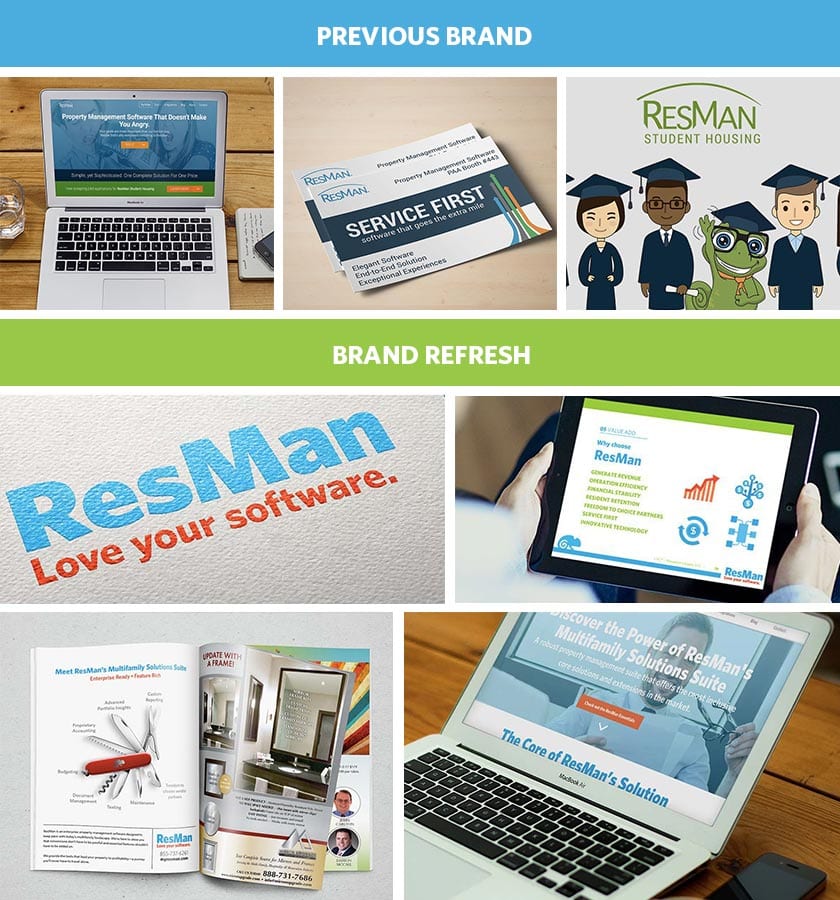
A brand refresh is not taken lightly by the Criterion.B team. As part of the auditing and assessment process, we interview key stakeholders both inside and outside our clients’ businesses. These interviews help us obtain a 360-degree view of the business. We then identify key opportunities with the content, visual language, and business goals to make smart and measurable recommendations.

The multifamily marketing industry — and your residents — are changing fast. Are your processes changing with them?
There were countless fantastic panels at NAA’s recent Apartmentalize conference, amazing speakers, and quality topics. But one really stood out to us: “Undercover Resident: The Genesis of a Community’s Reputation Begins Onsite, Not Online.”

But wait, we are a marketing company — shouldn’t we advocate for everything online? We do love digital marketing, but we also love people. This panel was a fantastic reminder of why we are in this business.
Too often, companies get sidetracked with what they are selling that they forget who they are selling to. We live in an age where texting supersedes talking. Yet, more than 700 residents across the nation admitted that personalized service goes further in their decision to renew than amenities.
With specialists from Rivergate KW, Apartment Life’s Cares Program, and The Franklin Johnson Group, this panel unpacked what residents really want. And it is different than what the staff thinks they want.
Attracting & Retaining Residents
Online marketing can be one of the most effective ways to draw and engage with residents. However, residents will ultimately choose to stay at your property if it feels like home.
Residents surveyed listed “engaging community events” as the No. 2 factor in their decision to renew a lease. They also ranked “sense of community” as a Top 5 reason to rent even when buying a home is an option.
With more generations renting now than ever before — and homeownership decreasing in nearly every age category — competition is ramping up in multifamily. This makes it more critical than ever for properties to both attract and retain residents.
If a property’s online presence and social media feed are updated and targeted, residents are more likely to be interested. However, if a prospective resident walks in the door and the leasing professional does not understand their life stage needs, how to adapt their sales strategy, or how to communicate with them most effectively, the prospect will likely flip from feeling impressed to feeling like a number, said Jackie Ratzlaff, Vice President of Growth Initiatives at Apartment Life Inc.
In other words, by upholding the same leasing practices you have always used, it will be less likely that you will be able to sell to multiple demographics successfully.
It’s important not to just be experts about your property’s physical space, but to know what resonates with each renter. This is called a buyer persona. A well-defined persona helps target your marketing efforts to the right people, at the right time, and in the right way.
Below we explore a few then-and-now comparisons of how renters in the multifamily market are evolving.
Then:
- Professionals rented urban apartments until they could buy a house.
- Families preferred to live in suburban apartments until they could buy a house or because of better schools.
- Retirement homes served as a final-stage home option for the senior population, predominantly due to declining health.
Now:
- Urban apartments or apartments with urban qualities attract both millennial professionals and Boomers. Boomers desire walkability and a new experience. Meanwhile, young professionals often place the convenience of their urban rental over homeownership even after starting a family.
- Suburban apartments in growing cities rival urban apartment features. They are new, sleek, and geared toward professionals who work away from city centers, or those who work remotely. They are no longer just for families but target a wide variety of demographics.
- Boomers and empty nesters desire a shared community with others in their stage of life and the convenience of walkability. Their health is not declining but is the main priority as they want to engage in activities (e.g., fitness, hobbies).
From increased technology and targeted social marketing campaigns to on-demand customer service, an enhanced online presence is essential. However, what is more important is focusing on the people you are selling to, then honing in on what will make them want to live at your property. Residents will renew their lease because of the way they feel, the way they are treated, and the community they have — not because of a great Instagram feed or a new fitness center.

Rethinking Your Customer Experience Strategy
Several multifamily properties are already rethinking how they do business.
Rivergate KW Residential, for example, is partnering with The Ritz Carlton to train their management staff on superior and personalized service that focuses on the people, according to Joya Pavesi, Vice President of Marketing and Strategy and one of the NAA panelists.
Cortland Partners appointed its first-ever Chief Experience Officer to develop a customer experience strategy and bring the brand to life across all touchpoints.
Apartment Life Inc.’s Cares Program helps properties increase retention by enhancing a sense of community through tailored monthly events, personalized visits, and resident care.
Finally, marketing agencies like Criterion.B are partnering with management companies to train staff on target buyer personas. Knowing this information helps you create content, design amenities, and understand the type of customer service needed to attract and retain your residents.
In short: Leasing is no longer an “amenities dump.” Instead, the onsite staff must connect with the people. Understanding their audience and targeting each sale and all corresponding communication to that person is the new norm in leasing.

Unlocking Success: The Critical Impact of Consistency in Content Marketing
We all know content marketing is king, but content is nothing without consistency. Organizations that produce engaging, steady content often achieve greater results. However, consistency is becoming an increasingly significant issue for many businesses.
With a solid content calendar, you can build stronger connections with your audience, hit touchpoints on the buyer’s journey, and position yourself as a trusted and valuable resource.

Why Is Content Marketing Consistency Important?
Grasping the attention of consumers has become a tough business. Traditional forms of mass marketing will no longer be an effective way to bring awareness to convert prospects into buyers.
Creating a few blogs or posting on social media here and there might help a prospective customer understand a topic better. Still, it will not help you hit all necessary touchpoints or build a meaningful relationship. If you are not a consistent content marketing creator, you are not fully connecting with your audience.
Consider your favorite actor, who probably stars in a few favorite movies. If she continues to select roles that you resonate with, eventually, you might find yourself interested in pretty much anything she is involved in. This is how to position your organization: as a well-known, trusted, and familiar resource consistently delivering great work.
How to Create a Strategy — and Stick to It
The solution to consistency is inbound marketing, a modern method that equips you to create content that drives buyer personas through your marketing funnel. The inbound marketing methodology will help guide the context your material should be used within and is based on four stages: attract, convert, close, and delight.
Attract
The attract stage is about building awareness and creating content that turns strangers into visitors. Thus, it would be best to focus primarily on blogs, social media, and white pages. The goal is to provide solutions to your persona’s problems. For example, for an urban apartment, you might write a blog highlighting “The Best Places to Eat Gelato” or “10 Interior Design Tips for a Loft Apartment.”
Convert
The convert stage is about converting visitors into leads. The type of content you are producing would be in the form of a call-to-action (CTA) or landing page. Create gated offers where viewers must provide minimal information valuable to your business (email, zip code, etc.). For example, offers can include infographics, fact sheets, eBooks, or how-to guides.
Close
In the close stage, your strategy should be all about turning leads into customers. In this stage, you should focus on your CRM, email, and workflows. It’s important to speak their language, meet their needs, and seal the deal.
Delight
In the delight stage, you will continue to provide value and show you care about your customers. In turn, they will become advocates and promoters for your business. Through social monitoring and surveys, you can see how satisfied your residents are, and if there is a problem, you can address it quickly. Happy customers are your best advocates for attracting new leads.
Knowing these stages and using them to create consistent and targeted content marketing can help you produce the right material in the right context for your persona.
The Key to Content Marketing Consistency
Running an inbound marketing campaign for your multifamily property can be difficult. Once you draft your buyer personas and map their journey, it’s time to create a campaign. But planning your social media calendar the first time is time-intensive, so we’ve put together this handy template to get you started.

In the world of digital marketing, it can be hard to know which tactic works best. These days, a lot of businesses mistakenly focus too much of their digital marketing efforts on one specific tactic like blogging or social media.

However, each part of your digital marketing strategy should fit together as one cohesive piece. Your website, social media presence, user experience (UX), customer experience (CX), etc. should all work together to create a successful inbound marketing plan.
Bring Them to You
Digital marketing and specifically inbound marketing is all about the consumer. However, it’s not about bombarding them with interruptive advertisements. It’s about providing relevant and helpful information to your customers. The internet has truly changed the flow of advertising because consumers are now able to research a product before making a purchase.
As a marketing professional, it’s important to think of yourself more as a resource than a salesperson. People will want to come to you if you’re providing the right kind of information. When people see you as an asset, they’ll feel a sense of trust.
Research Your Audience
The first thing you need to do to serve as this resource to your consumer is to identify your audience. A multifamily property in downtown Dallas may know that a typical resident is a young professional between the ages of 23 and 30, but that doesn’t tell the whole story. Using market research, you can analyze who your target market is beyond the typical demographics, and begin to understand their needs, their pain points, and where they might seek out information.
A combination of market research and customer interviews can help you create buyer personas. Per HubSpot, a buyer persona is the creation of a semi-fictional profile. The persona profile should include a narrative of day-to-day interactions, demographic behavior, goals, pain points, what his/her search process has been, the type of experience desired, common objections, and a photo of your persona.
Most businesses have multiple buyer personas to understand the full scope of the audience that uses their product or service. Having a unique profile for each persona is important. Your buyer personas should inform everything you do and are integral to your digital marketing strategy.
The Perfect Content
Once you have a persona, the next step is attracting people through content creation. According to HubSpot, businesses should focus on “creating quality content that pulls people toward your company and product, where they naturally want to be. By aligning the content you publish with your customer’s interests, you naturally attract inbound traffic that you can then convert, close, and delight over time.”
Now here’s the caveat: According to SingleGrain, you should be spending about 80% of your time promoting your content and 20% of your time creating it. Think about it, If you have the world’s best content but people aren’t seeing it, what’s the point? It’s like the old adage about a tree falling in the forest when no one’s around to hear it — did it really fall? While creating relevant content is incredibly important, it’s the promotion of that content that is imperative.
Now, this is where the other elements of your digital marketing strategy can come into play. Each of these tactics should work together to build a well-rounded digital marketing campaign. These tactics are more effective in working together because the inbound methodology builds on each tactic to create a strategy.
Digital Marketing Elements: Email, Web, Social Media
Email marketing, for example, is considered to be one of the strongest tactics for nurturing leads. Integrating a strong email campaign into your digital marketing strategy is an important part of converting leads to leases. However, it’s most effective when pushing out sharable content that will lead customers down a purchase path.
Email marketing is also a great tool for tracking your target market so you can inform your content strategy. Based on the number of email opens and the clickthrough rate, you can see what kind of material your prospects are interested in.
This is also the case on your website. Automation allows you to track what your website visitors are doing on your site. Using this newly gathered information, you can help move leads along in a more personalized and effective way.
Knowing the content your audience is interested in is also helpful in social media as you’re able to show them what they want to see. Your user experience (UX) and customer experience (CX) also tie into this notion. The better the experience your potential clients have, the more interest they will have in moving forward with you. The same works for existing clients. About 83% of customers who experience positive interactions with brands are willing to offer referrals.
The integration of all aspects of the inbound methodology will differentiate you from the competition. You need more than a few social media pages or an automated email campaign to be successful. A full digital marketing strategy includes these elements and builds on them as a part of a comprehensive plan. It’s the combination of these strategies that will truly make your digital marketing strategy successful.

Renting Smarter: Adapting to the New Affordability Landscape
The multifamily market is at a turning point. As a surge of new, high-end Class A apartment developments hit the market, we’re seeing a domino effect reshaping affordability and strategy across the industry.
While the influx of luxury units may seem like a win for renters seeking premium amenities, it’s creating a ripple that impacts far more than the top tier.

In reality, this trend is compressing rents across Class A, B, and even C properties, reshuffling renter expectations and forcing owners and operators to adapt in real time.
This reshuffling is “forcing owners of Class B and C properties to adapt to shifting demand and pricing pressures,” said Jason Donajkowski, Broker/Owner of Paragon Property Management Group. High-end buildings are aggressively offering lease-up concessions, and that means renters, many of whom would typically gravitate toward Class B housing, are now lured by discounted luxury.
The Realignment of Renter Expectations
The impact is clear: residents who once viewed Class A as aspirational now see it as accessible. In many high-growth metros, the rent gap between new Class A and older Class B properties has shrunk. As a result, Class B operators are forced to drop prices or sweeten incentives, cascading further into the Class C market. This creates a short-term gain in affordability for renters, but a long-term strategic challenge for operators.
The question becomes: how can owners maintain occupancy, protect NOI, and continue to stand out in a saturated, value-conscious market?
1. Smart Investments Over Luxury Overhauls
To stay competitive, many multifamily owners are turning to strategic, value-add renovations. But these improvements must be cost-effective. “Targeted upgrades that enhance appeal without excessive spending are key,” said Donajkowski. Think updated appliances, modernizing kitchens, smart home tech, or refreshed landscaping — not full-scale luxury transformations.
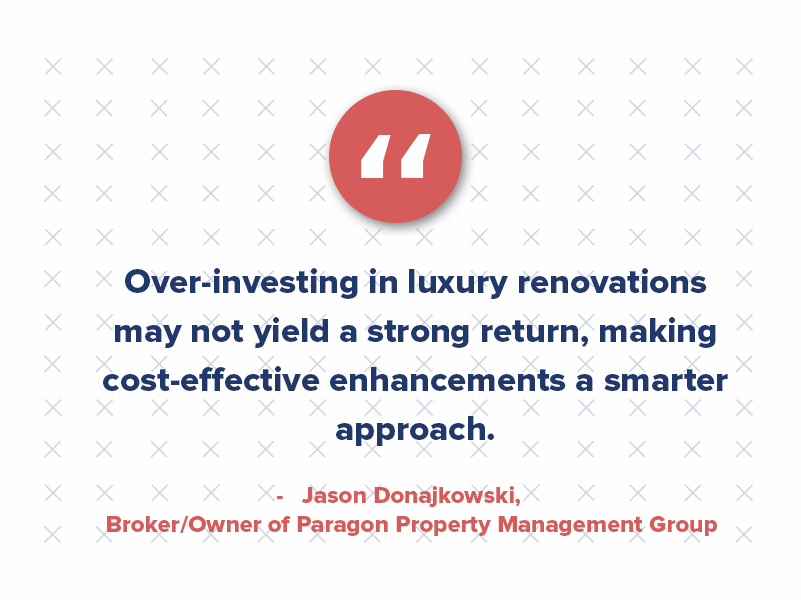
Oliver Morrisey, owner and director of Empower Wills & Estate Lawyers, echoes this sentiment from his own experience. “We updated kitchens and bathrooms in a few units and gave the common areas a fresh look,” he shared. “These changes helped attract better tenants and fill vacancies faster.”
2. Incentives That Work Harder Than Discounts
Incentives are another effective tool in this new market dynamic. “Offering strategic incentives such as move-in specials or flexible lease terms can help attract tenants without permanently lowering rents,” said Parker McInnis, Owner of Speedy Sale Home Buyers.
“Owners and operators should consider perks like free parking spaces, gym memberships, or discounted rent for long-term leases,” said John Medina, CEO of John Medina Buys Houses. “These types of value-adds can tip the scales in your favor when renters are choosing between properties.”
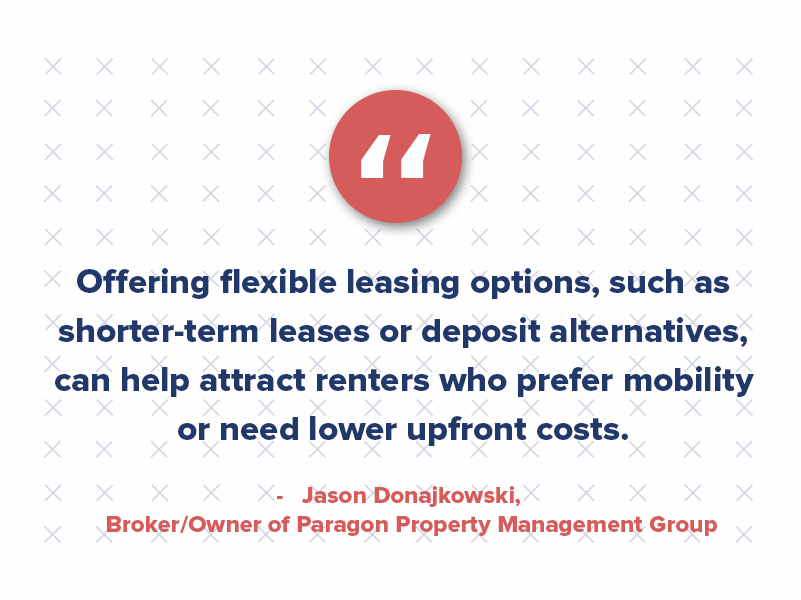
3. Differentiate With Experience and Service
In a competitive market, operational excellence is the new luxury. “Superior customer service is key,” said Steve Fleurant, CEO of Clair Services. “Some IT upgrades can contribute to customer experiences and lead to better retention.”
For Class B and C properties, the renter experience may be the biggest differentiator. “Offer unique amenities like co-working spaces, smart tech, or sustainable features,” said Ryan Nelson, founder of PropertyBuild. “And tailor your marketing to specific demographics such as young professionals or remote workers.”
4. Balancing Tech, Efficiency, and Human Touch
Technology is another way to remain nimble without overspending. Property owners can reduce operational costs and stay agile in changing market conditions, from dynamic pricing tools to energy-efficient upgrades.
Anupa Rongala, CEO of Invensis Technologies noted, “Moving into 2025 and beyond, success will hinge on agility leveraging dynamic pricing models that respond to real-time market conditions, optimizing operational efficiencies, and investing in targeted property enhancements. Rather than engaging in a race to the bottom with rent reductions, owners should focus on value-driven differentiation.”
5. Stay Grounded in What Renters Really Want
Finally, focus on what your renters are actually asking for — often, it’s value, flexibility, and trust.
“Investors should prioritize sustainable upgrades and personalized experiences,” advises Saddat Abid, CEO of Property Saviour. “This not only boosts NOI but enhances property appeal and tenant satisfaction.”
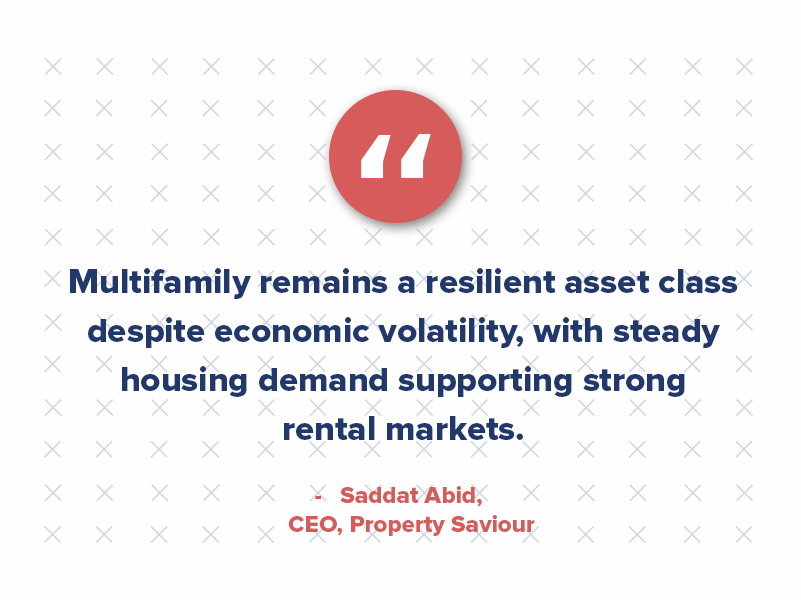
Looking Ahead
The multifamily industry isn’t immune to the growing pains of increased development. But owners and operators can remain competitive and even thrive by leaning into smarter, more personalized strategies — value-added upgrades, operational efficiency, and renter-focused amenities.
As market-rate affordability continues to evolve, staying grounded in renter needs and embracing agile strategies will be the key to long-term performance and resilience across all asset classes.

The Power of User-Generated Content in 2025
User-generated content (UGC) has been a cornerstone of digital marketing for years, but in 2025, its impact is more significant than ever.
With social media algorithms prioritizing authentic, community-driven content and consumers growing increasingly skeptical of traditional advertising, UGC is not just a nice-to-have — it’s a necessity.
UGC continues evolving from customer reviews and social media posts to video testimonials and influencer collaborations, shaping how brands connect with their audiences.

Why UGC is More Powerful Than Ever in 2025
Consumers trust real people more than they trust brands — plain and simple.
According to Tint’s 2024 State of UGC Report, 79% of people say UGC highly impacts their purchasing decisions, and 85% of consumers find UGC more influential than brand-created content.
This shift is largely due to the changing nature of social media and digital engagement. While polished, branded content still has its place, consumers now crave authenticity. Studies show that 90% of consumers say authenticity is important when deciding which brands to support. That means staged photoshoots and scripted testimonials don’t have the same impact they once did. Instead, audiences are drawn to real, unfiltered content from their peers.
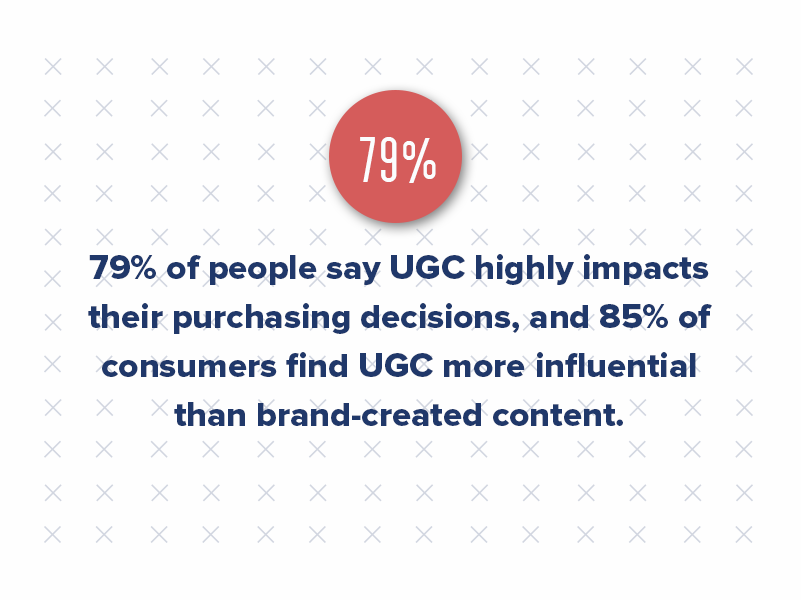
The Algorithm Shift: Prioritizing UGC
Social media platforms are favoring UGC more than ever before. In 2024, Instagram, TikTok, and YouTube updated their algorithms to push more community-driven content to the forefront. This means:
- Brand-generated posts see less reach compared to organic, unpaid UGC.
- TikTok’s “For You” page prioritizes videos with high engagement, meaning a single customer review can go viral overnight.
- Instagram’s Collab feature and Threads integration encourage more organic conversations around brands, making real customer stories even more powerful.
- YouTube Shorts has become a hotspot for UGC-based tutorials and testimonials, with short-form video consumption at an all-time high.
This means brands that rely solely on professional content without leveraging UGC are missing out on massive organic reach.
How UGC Has Evolved in the Last Year
1. AI-Enhanced UGC
Artificial intelligence is now a part of the UGC landscape. Brands use AI to curate, analyze, and optimize UGC in real time. Tools like ChatGPT, Synthesia, and Runway allow marketers to personalize user content without losing authenticity. AI-assisted video editing helps create a more professional-looking UGC without diminishing its raw, organic appeal.
2. The Rise of Micro-Influencers & Nano-Influencers
Consumers trust everyday people more than celebrity endorsements. That’s why micro- and nano-influencers (accounts with 1,000–50,000 followers) now drive 60% more engagement than traditional influencers, according to Influencer Marketing Hub.
Brands are tapping into everyday customers, encouraging them to share experiences rather than relying on influencers with millions of followers. In fact, 80% of marketers say micro-influencer UGC is more effective at driving conversions than influencer partnerships with over 500K followers.
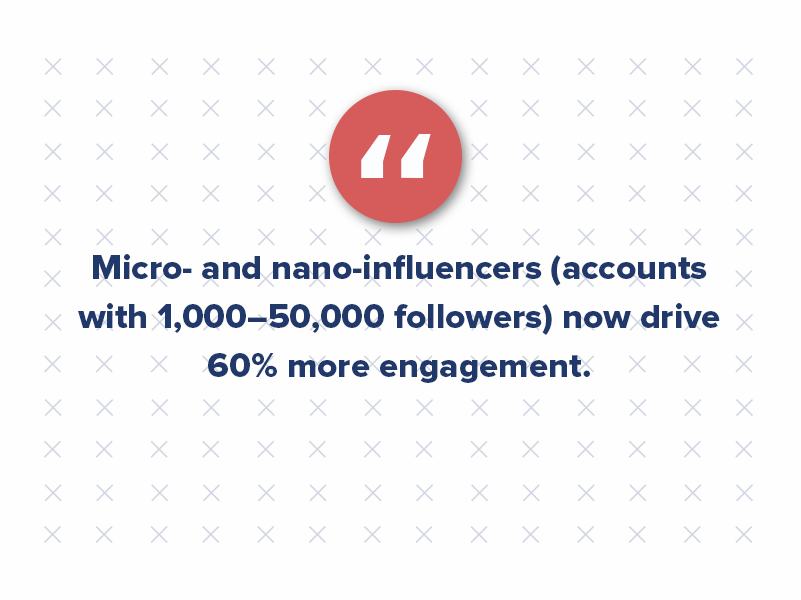
3. Long-Form UGC is Making a Comeback
Short-form content dominated the landscape in recent years, but long-form UGC is making a strong return in 2025. Consumers want deeper, more meaningful content from real users, leading to a rise in:
- YouTube vlogs and product deep dives
- Long-form customer reviews on LinkedIn
- Reddit and forum-based testimonials
- TikTok mini-docuseries featuring real customer experiences
These long-form pieces build stronger emotional connections with potential buyers, making them more likely to convert.
Examples of Successful UGC Campaigns in 2025
1. Airbnb’s “Host Stories” Series
Airbnb has capitalized on UGC by featuring real hosts sharing their experiences in short, engaging videos. The company highlights their struggles, successes, and what hosting means to them — turning everyday people into brand ambassadors. According to Airbnb, this strategy has led to a 30% increase in bookings from new hosts.
2. Starbucks’ “Red Cup Challenge”
Starbucks sees a flood of organic content every holiday season with its iconic red cups. Instead of creating their own marketing push, they launched the Red Cup Challenge, where customers were encouraged to post their most creative coffee moments. The result? Over 2.5 million Instagram posts featuring their holiday cups, making it one of their most successful UGC campaigns yet.

3. Nike’s “You Got This” Campaign
Nike’s newest campaign taps into real athletes and everyday people overcoming challenges. By encouraging users to share their fitness journeys using the hashtag #YouGotThis, Nike generated over 1 billion views on TikTok in just three months. This campaign resonated with consumers because it focused on real people, struggles, and triumphs rather than traditional ad campaigns.
How to Leverage UGC for Your Brand in 2025
1. Make UGC Part of Your SEO Strategy
Did you know that UGC can boost your search rankings? Google’s algorithm now prioritizes customer reviews, forum discussions, and social proof in its results. Encouraging UGC not only builds credibility but also enhances your online visibility.
2. Encourage Authenticity Over Perfection
Consumers can spot fake UGC from a mile away. Instead of overly polished testimonials, encourage raw, unfiltered content — even if it’s not 100% perfect. Brands like Glossier and Gymshark have built massive followings by leveraging real customer content.
3. Feature UGC Across Multiple Channels
Don’t just keep UGC on social media. Repurpose it in email campaigns, digital ads, and even product pages on your website. Some ways to incorporate UGC include:
- Adding Instagram photos to product pages
- Featuring real customer testimonials in email marketing
- Using customer-submitted videos in paid social ads
4. Launch a UGC Incentive Program
Want more UGC? Give your audience a reason to participate. Offer discounts, exclusive access, or giveaways in exchange for high-quality content. Programs like Lululemon’s Ambassador Program and Sephora’s Beauty Insider Community thrive because they reward customers for their content contributions.
The Future of UGC in 2025 & Beyond
User-generated content isn’t just a marketing trend — it’s the backbone of modern brand trust and engagement. As AI-driven content creation grows, UGC will remain one of the last true sources of authenticity in marketing.
Brands that harness the power of UGC will see higher engagement, better conversions, and a stronger connection with their audience. Those that don’t? They risk falling behind in an era where consumers crave real over manufactured.
If you’re not already prioritizing UGC, now’s the time. Because in 2025, the brands that succeed won’t be the loudest — they’ll be the most authentic.

Why Our Agency Doesn’t Manage TikTok for Apartments
With its skyrocketing user base and trendsetting influence, TikTok has become a platform that marketers cannot ignore.
As of 2024, TikTok boasts over 1 billion active users, many of whom are from younger demographics, increasingly driving consumer trends. In fact, a third of U.S. adults say they use TikTok, including 39% of adults aged 30-49, and 24% of adults aged 50-64.
But for multifamily marketers, the question remains: Is TikTok worth the time and resources? Can it really deliver tangible results, such as leases, or is it just an engaging addition to the marketing mix without a direct return?

The Rise of TikTok (and What This Means for Multifamily)
TikTok’s rapid growth is undeniable. The platform’s focus on short-form, engaging video content has set it apart from other social platforms. It’s a platform built for quick, organic reach where content has the chance to go viral and capture massive amounts of attention overnight. For multifamily marketers, the opportunity to creatively showcase properties, amenities, and community culture is enticing.
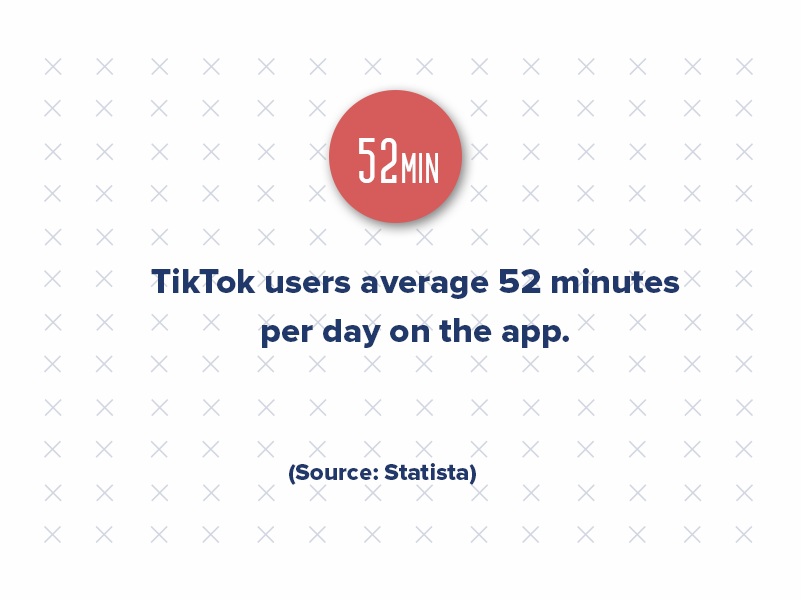
According to recent data, TikTok users average 52 minutes per day on the app, more than many other platforms, suggesting strong engagement levels that could translate to brand recognition and retention.
Many apartment communities have hopped on board, creating property tours, resident testimonials, and local event features to attract prospective renters and engage current residents.
Authenticity on TikTok vs. Agency Management
While TikTok offers unique opportunities for multifamily marketers, the nature of its content poses challenges for agencies aiming to manage this platform on behalf of properties.
Authenticity is essential on TikTok, as its algorithm favors content that feels organic, spontaneous, and genuine — qualities that often come directly from community members or on-site property staff. This focus on realness can make it difficult for agencies to effectively manage a property’s TikTok presence.
Users are drawn to content that feels relatable and unpolished, making videos created by residents or on-site staff more impactful than those produced by external teams.
As Bryan Melchert, owner of Mitten Home Buyer, puts it, “I’ve found success showcasing our renovations and community events. It’s challenging to balance authenticity with polished content, but TikTok’s reach makes it worthwhile. I believe investing time in TikTok pays off more than other platforms — the engagement we get is unmatched.”
This emphasis on authenticity introduces a tension when it comes to agency-created content. Agencies often aim for professional, polished materials, which don’t always resonate with TikTok audiences seeking a more casual, behind-the-scenes experience.
As Melchert points out, “Just be prepared for a learning curve as you figure out what resonates with your local audience.”
For multifamily properties, user-generated content like community events, renovation highlights, and property tours can drive the kind of authentic engagement TikTok rewards.
Another challenge lies in TikTok’s algorithm and ad offerings, which don’t align well with the specific needs of multifamily properties looking to reach local, high-intent audiences.
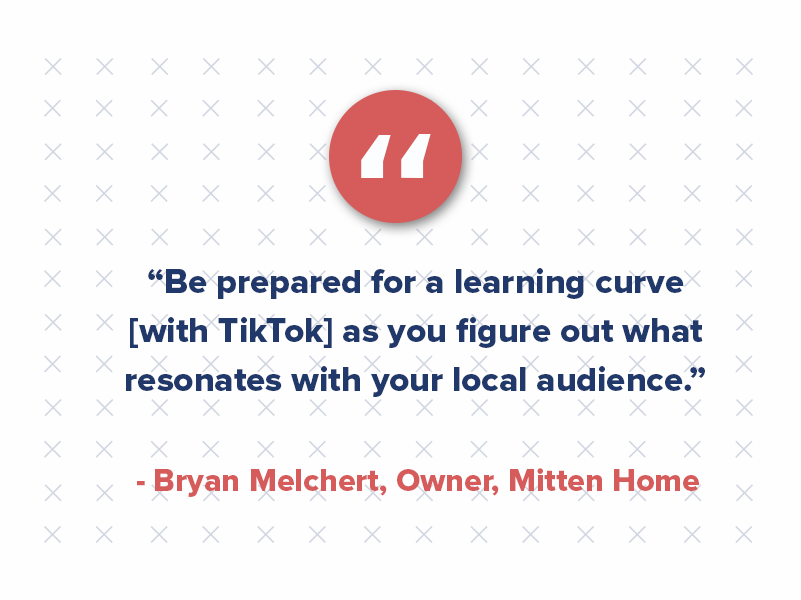
Here are some key reasons why an agency-managed TikTok strategy may not be as effective as expected:
- Lack of Geographic Targeting: Unlike Facebook or Google, TikTok lacks precise geo-targeting options. Marketers cannot narrow their target audience by zip code, which is a significant drawback for multifamily properties targeting potential renters within specific geographic areas.
- Audience Intent: TikTok users typically engage with entertaining, light-hearted content, meaning they may not be in a “searching for an apartment” mindset. Even if a property goes viral, there’s no guarantee that those interactions will convert to leases.
- The Importance of Authenticity: TikTok’s algorithm favors authentic, user-generated content over polished, brand-generated posts. Agencies managing TikTok often struggle to replicate the genuine tone that resonates on the platform.
Understanding Boosting on TikTok
Boosting posts on TikTok offers some value but is limited by the platform’s lack of precise targeting options.
Although boosting can amplify reach and engagement, the challenge is that boosted posts don’t necessarily reach the audience most likely to convert into renters. Much like Facebook advertising, TikTok lacks refined geographic targeting capabilities, critical for multifamily properties seeking to attract prospective residents within a local radius.
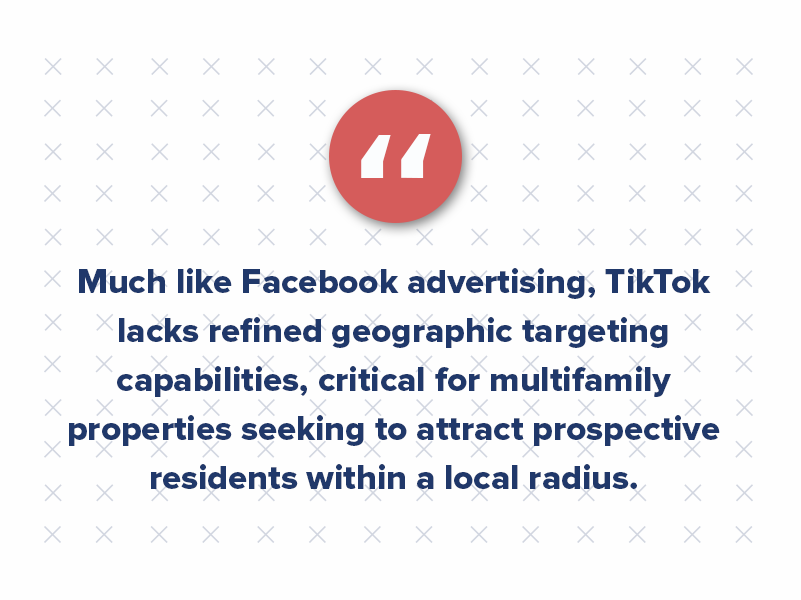
Here’s a closer look at the limitations and insights on boosting:
Reach Without Precision
Boosting posts on TikTok can expand reach significantly, but for multifamily marketers, the platform’s limited geographic targeting presents a challenge. While TikTok offers broad regional targeting, it lacks precision, making it difficult for properties in specific areas to reach local audiences effectively. For instance, a property in Austin, Texas, may find its boosted posts displayed statewide, nationwide, or even internationally — audiences unlikely to translate into viable leads.
Erik Wright, CEO of New Horizon Home Buyers, has seen this firsthand. “Boosted posts definitely do better when targeted locally — we saw about 3x more engagement,” Wright shares, highlighting the need for tighter geographic targeting. However, he notes that focusing on neighborhood amenities and lifestyle content has helped bypass Fair Housing limitations while still reaching relevant audiences. “It’s been worth investing some time in TikTok, especially for reaching younger renters. The organic reach is still pretty good compared to other platforms,” Wright adds. His team has generated qualified leads by creating engaging property tour videos and leaning into organic reach.
Wright’s approach aligns with the strategies used by Carl Fanaro, president of NOLA Buys Houses. “It’s definitely challenging to navigate Fair Housing regulations with limited targeting options, but we’ve found creative ways to work around it,” said Fanaro. Instead of targeting specific demographics, Fanaro’s team creates content that showcases property amenities and local attractions, naturally drawing in their target audience. “While it takes time and effort, I believe TikTok is worth investing in alongside other platforms.”
Despite the challenges, Wright and Fanaro find that TikTok’s organic reach is still competitive, especially for property tour videos and local lifestyle content. “The organic reach is still pretty good compared to other platforms,” Wright said. “We’ve gotten some good leads from fun property tour videos.” His advice? Give TikTok a try — but don’t neglect other channels that may offer more precise targeting and higher conversions.
Cost Efficiency and ROI
TikTok’s ad costs are generally lower than those of Google or Facebook. However, the limited targeting options mean marketers often pay for user engagement outside their desired demographic or geographic area. This cost-per-engagement approach can yield poor ROI for multifamily marketers focused on local leasing goals, whereas other platforms with more defined targeting options may yield better results.
Is Organic TikTok Growth Worth the Time?
TikTok’s organic reach is a strong point for many brands, allowing them to reach vast audiences without spending a dime. For multifamily marketers, organic reach can help boost brand recognition and attract potential renters with engaging, lifestyle-focused content that conveys the property’s culture.
However, organic reach on TikTok is a double-edged sword:
Viral Potential vs. Geographic Relevance
While TikTok offers high organic reach and viral potential, the lack of geographic targeting means that even widely shared posts may have little to no impact on actual leasing.
A video that garners thousands of views or goes viral may sound impressive, but there’s limited leasing impact if those viewers aren’t within a reasonable distance of the property. Engagement doesn’t always equal conversions. This audience could be scattered across the country — even globally — and might not align with the target demographic of potential local renters. This can result in minimal to no impact on lease conversions, highlighting one of the main challenges with TikTok’s reach.
In fact, while boosted posts do increase visibility, research from Influencer Marketing Hub suggests that boosted TikTok content rarely results in more qualified leads. Though enticing, achieving viral success on TikTok can be difficult to replicate and requires a steady stream of authentic, engaging content. Consistency is essential, and the nature of viral content often means investing time and creativity to maintain high-quality posting.
According to Sprout Social, TikTok has one of the highest engagement rates across platforms at 2.65%, far exceeding Instagram’s 0.70%. In certain sectors, like education, food and beverage, and travel, brands experience engagement rates as high as 4.9%. While this engagement might make TikTok appear valuable, the conversion rate doesn’t always match up, especially for multifamily properties needing hyper-local audiences.
It’s also worth noting that TikTok’s engagement rate has been dropping, with last year scoring a 35% decrease in the engagement rate by followers and a 20% decrease in the engagement by views.
Justin Landis, founder of The Justin Landis Group, highlights that success on TikTok largely depends on the audience: “It depends on your audience whether TikTok is worth the investment compared to other platforms. TikTok is worth the effort if your target renters are younger or more tech-savvy. The platform’s viral potential and organic reach can outperform other social platforms, especially for multifamily properties looking to create a fresh, community-focused image. However, a balanced approach with Facebook or Instagram may yield better results for broader or older demographics.”
In multifamily marketing, reaching the right people can be more valuable than reaching a large audience. While TikTok’s potential for engagement is appealing, multifamily properties must weigh whether that engagement leads to tangible results.
The Role of Short-Lived Content
TikTok content is often ephemeral, with most videos having a short lifespan. While TikTok videos can experience bursts of popularity, the attention span is fleeting. This rapid content turnover means that while posts can gain significant engagement quickly, their shelf-life may not justify the investment for long-term leasing goals.
Algorithm-Driven Success
TikTok’s algorithm promotes attention-grabbing videos that appeal to a broad audience, which doesn’t necessarily align with multifamily properties’ specific needs. For example, a video of a property’s pet-friendly amenities may receive plenty of engagement but won’t guarantee leases if viewers aren’t in the area.
What Are the Alternatives to TikTok for Multifamily Marketing?
While Criterion.B is not advising against using TikTok (after all, it’s clearly a booming platform with a growing user base and beneficial for marketing your property to Gen Z), we just advise against using or hiring an agency to help with it.
With TikTok’s massive reach, there’s no denying the platform’s value, but the unique and time-intensive nature of content creation there means that an onsite team can often create more genuine and effective posts.
However, if finding time for this is a challenge, there are alternative platforms and strategies to consider that may yield a more targeted ROI. Here are some options to help balance your digital presence and focus resources wisely (these are also resources a digital marketing agency can easily help you with).
- Local SEO and Google My Business: Optimizing for local search can help properties reach renters actively searching for nearby apartments. Local SEO also offers precise targeting that’s not achievable with TikTok ads.
- YouTube Video Tours: YouTube offers better search functionality and longer video lifespan than TikTok as well as more precise targeting based on location, age, and intent.
- Content Marketing: Creating blog content, virtual tours, and high-quality social media posts on Facebook and Instagram can drive more long-term engagement and SEO value for multifamily properties.
TikTok’s Role in Multifamily Marketing
While TikTok’s explosive growth and impressive engagement rates make it an exciting platform, the drawbacks for multifamily marketers are significant. Without precise targeting capabilities and a way to ensure engagement from geographically relevant audiences, TikTok can be a high-risk, low-reward platform for multifamily properties focused on driving leases.
The potential for increased brand awareness is undeniable, but multifamily marketers should weigh the platform’s limitations and consider if TikTok’s reach aligns with their objectives. Given the lack of geographic targeting and limited conversion potential, Criterion.B advises a cautious approach to TikTok marketing and instead suggests focusing on more reliable, targeted platforms that allow for a greater focus on ROI.
While TikTok may be a fun addition to the marketing mix, the key lies in balancing the need for engaging content with the right targeting approach to maximize your property’s leasing efforts.

Marketing Strategies for Multifamily Amid Political Uncertainty
The political season brings unique challenges to apartment leasing and multifamily marketing, particularly during the fall, which is already known for its leasing slump.
Political campaigns and ads flood online spaces as the market slows, causing distractions and limiting the attention available for leasing advertisements. This can reduce engagement, making it harder for property managers to capture leads.

Historically, the fall season tends to be slower for apartment leasing. Students are back in school, families are settled, and fewer people want to move before the holiday season.
This natural slump is amplified during a political season when social media feeds and digital spaces are dominated by election content.
Lower Engagement, Higher Ad Prices
According to industry data, non-political ad engagement can drop by as much as 17% during election years. This is particularly relevant for apartment leasing as potential renters may focus more on current events than property searches. People may focus more on political news and debates, resulting in lower engagement with non-political content. Renters may also delay moving or leasing decisions due to economic uncertainty tied to potential policy changes.
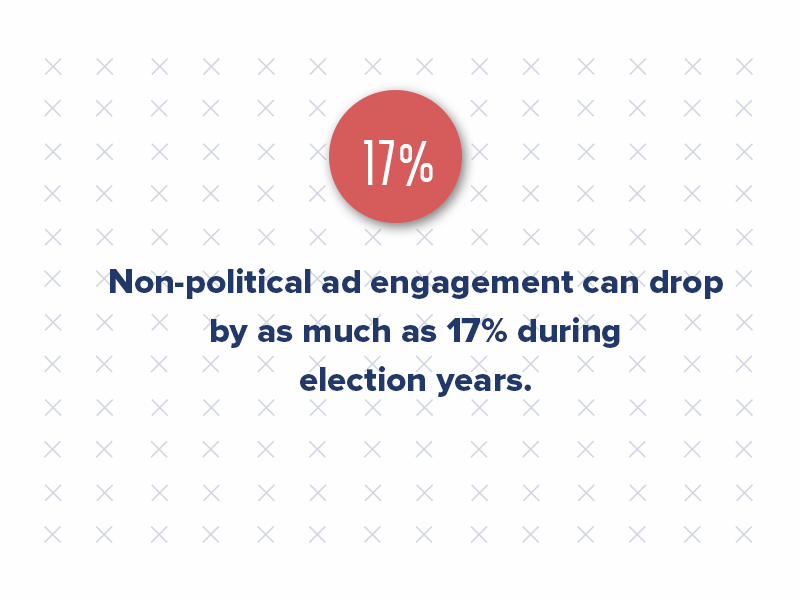
In addition, political campaigns drive up the cost of digital advertising, with social media ad prices increasing by as much as 10-20% during these periods. This adds extra pressure to maintain a competitive advertising strategy.
With candidates and political action committees pouring millions into ad campaigns, businesses compete for limited ad space. According to AdImpact, political ad spending in the 2020 U.S. election cycle exceeded $9 billion, doubling the 2016 figure. This surge significantly raised the cost of TV, digital, and social media advertising, sometimes by as much as 30-40%, according to Kantar Media.
The cost-per-click (CPC) for online ads also rises during election periods. A Buffer report from 2020 showed that CPC on platforms like Facebook and Google Ads increased by 10-20% during the political season, as advertisers had to compete with campaigns seeking maximum visibility.
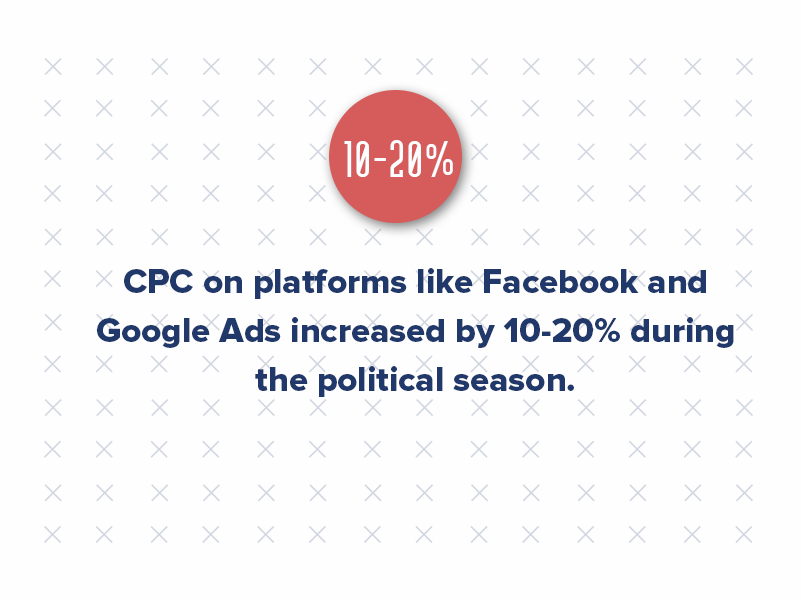
This higher competition can drain marketing budgets for non-political advertisers, forcing them to rethink their strategies by increasing spending or shifting focus to more niche or less saturated platforms.
Renters May Delay Leasing Decisions
Renters often become cautious about making big decisions, like signing a lease, during periods of economic uncertainty tied to potential policy changes. This hesitation stems from concerns over shifting government policies that could impact everything from rent control laws to mortgage interest rates.
During election years, when tax policies, economic reforms, and housing regulations are up in the air, renters may hold off on moving, waiting to see how the political landscape will impact their personal finances. In fact, Freddie Mac reports that economic uncertainty, especially around housing policies, directly influences consumer confidence and, subsequently, leasing decisions.
As election cycles tend to introduce unpredictability, both businesses and individuals anticipate potential economic shifts. Renters may fear that political decisions could increase rental rates, alter job markets, or introduce new tax laws that affect affordability. Consequently, they may extend their current leases or delay moving into new apartments until the economic outlook stabilizes post-election.
Businesses May Pull Back on Multifamily Marketing
In parallel, as economic uncertainty rises during elections, businesses — including those in multifamily housing — may reduce their marketing budgets. Historically, companies adopt a “wait and see” approach during politically turbulent times.
According to Nielsen, in 2020, 42% of businesses planned to pause or reduce their marketing spending leading up to the election, anticipating economic shifts and increased ad competition from political campaigns. This pullback can affect lead generation and visibility, especially when paired with the rising costs of ad placements during this time due to heightened competition.
However, cutting back on marketing during election years may backfire. A Harvard Business Review study revealed that companies maintaining or increasing their ad spend during uncertain times could capture marketshare from competitors who pulled back. While reducing spending may feel like a safeguard against potential economic changes, maintaining a presence can help brands remain top-of-mind when the uncertainty settles.
How to Combat the Apartment Leasing Slump
According to previous election data, interest rates, home prices, and rental demand can all fluctuate as renters and buyers adopt a wait-and-see approach. This behavior is often influenced by broader economic concerns tied to political outcomes. In contrast to the real estate market, which can experience price surges or declines during an election, the rental market may face a cooling effect as people delay decisions until there is more economic clarity.
However, there are ways to combat the slump. Despite these challenges, property managers and leasing professionals can adopt strategies to maintain momentum. Focusing on targeted, hyper-local marketing strategies can mitigate the impact of political noise. This means staying agile with campaigns, using real-time data, and adjusting content to address potential renters’ concerns and uncertainties.
Promoting flexible lease terms, offering incentives, and ramping up virtual tours or online engagements can also help keep interest alive during politically charged times.
1. Increase Your Digital Presence
With distractions from political content, ensuring your property remains visible online is crucial. A well-optimized website with clear calls to action and engaging content can help keep prospective renters focused on your property.
2. Leverage Local SEO
As the competition for attention heats up, having a strong local SEO strategy can make a big difference. According to HubSpot, businesses that optimize for local search see a 126% increase in visits from consumers ready to convert. This is especially important during political seasons when national news can drown out non-political content.
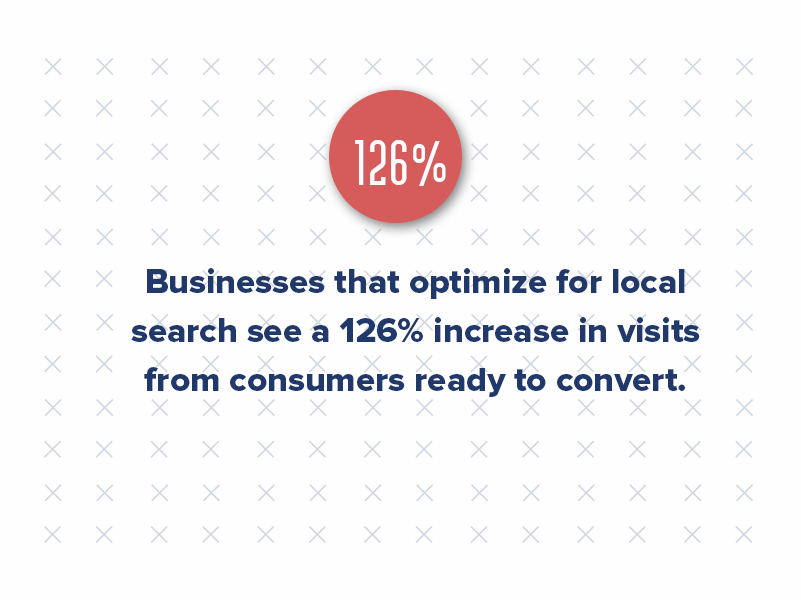
3. Diversify Your Advertising Channels
Given the rise in social media advertising costs, consider diversifying your ad spend across different platforms. Instead of relying solely on Facebook or Instagram, explore Google Ads, Bing, and even niche real estate platforms like Zillow or Apartments.com. Diversification allows you to reach audiences in less competitive spaces.
4. Emphasize Community and Resident Stories
In times of political noise, authentic, community-driven content resonates well. Share testimonials, resident stories, and highlight local events. This showcases your property and appeals to renters looking for a genuine connection.
5. Invest in Retargeting Ads
If prospective renters visit your website but don’t convert immediately, retargeting ads can bring them back. These ads remind potential renters of your property, helping you stay top of mind despite political distractions.
Strategies for Continued Multifamily Success
The need for adaptive strategies becomes even more apparent as political seasons influence the apartment leasing market. With voter behavior and market dynamics shifting, renters and property owners face unique challenges during election years.
To stay competitive, multifamily properties must refine their marketing efforts, focus on resident retention, and remain agile in response to fluctuating demand. Leveraging data-driven insights and maintaining an online presence will be crucial for apartment owners to navigate the uncertainties of the political climate and ensure continued growth and stability in their leasing operations.
The Effectiveness of Predictive Advertising in Multifamily
Predictive advertising has been touted as “the next big thing” in digital marketing — promising marketers smarter targeting, better-qualified leads, and cost-effective ad spend.
Other companies have championed the technology, claiming that predictive analytics can help forecast future renter behavior based on past data, making ad targeting more precise and impactful. But is predictive advertising really the game-changer it claims to be? Does it deliver “said results?”

After digging into recent research and analyzing industry results from the last year, the evidence suggests that the effectiveness of predictive ads, especially in multifamily marketing, may not be as clear-cut as proponents would like us to believe.
In fact, we’ve found that more transparent strategies can often deliver better results, which is why we’ve steered away from predictive ad services.
Let’s explore why predictive ads fall short and why Criterion.B takes a more straightforward approach to multifamily marketing.

What Is Predictive Advertising?
If you have spent time working on digital ads, you know the cost has risen significantly in recent years. Meta’s cost per thousand (CPM) has increased 61% yearly, and Google’s programmatic display CPMs increased 75% in the same period, according to The Drum. Meanwhile, many brands are tightening their budgets due to economic uncertainty, yet consumers are expecting better ad targeting, personalization, and overall messaging than ever before.
So how have advertisers and agencies attempted to combat this? Well, they’ve been dabbling in predictive ads (or trying).
“We rushed into [predictive advertising], hoping for big returns but ended up spending too much with little to show for it,” said James Heartquist, owner at Modern Property Solutions. “Our main problem was not using our budget wisely, which led to few sales.”
Predictive analytics uses artificial intelligence (AI) and data from past campaigns to forecast future behaviors. In theory, it allows marketers to target potential renters before they know they’re in the market for an apartment. The idea is simple: by using data like browsing habits, previous searches, demographics, subscriptions, and demographic information, you can predict who is most likely to convert and target your ads accordingly.
Predictive advertising is a subset of predictive analytics that uses historical data, machine learning techniques, and algorithms to target audiences and optimize ad copy and media spending accurately.
In essence, predictive advertising enables brands to build highly targeted audience segments based on millions of behavioral signals and customer attributes. There are several key techniques used in predictive advertising, each offering different levels of sophistication and impact:
- Look-alike modeling: This technique identifies new users who resemble an existing customer group. It’s a simple approach often built into platforms like Facebook and LinkedIn.
- Classification modeling: Similar to look-alike modeling but with an additional layer of filtering, this method excludes users who aren’t ideal targets.
- Click-based optimization: By analyzing user intent, AI predicts the likelihood that a customer will take specific actions, such as clicking on an ad or making a purchase.
- Uplift modeling: This advanced technique predicts how an ad or intervention will affect a customer’s likelihood of purchasing, giving brands even deeper insight into campaign effectiveness.
The Predictive Ads Promise vs. Reality
Companies promote predictive advertising as a way to get more qualified multifamily leads at a lower cost. According to them, this technology helps to refine Google Ads targeting and reach potential renters earlier in their decision-making process.
While this sounds great in theory, industry research shows the results aren’t always as successful as predicted. The goal is to create a more personalized and timely ad experience, but predictive ads can struggle with accuracy as they rely on assumptions about behavior that can be hard to validate. As multifamily experts highlight, the unpredictable nature of renter decision-making makes it difficult for these systems to consistently deliver better conversion rates.
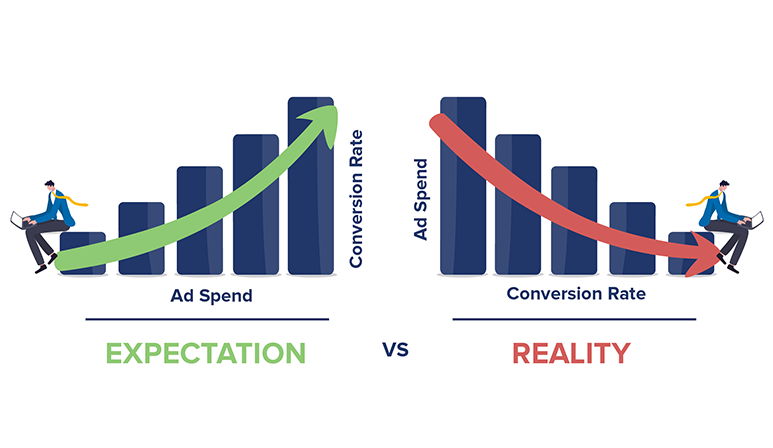
Recent Conversion Logix data showed that while predictive ads could improve click-through rates, the conversion rates (lead-to-lease) weren’t significantly better compared to more straightforward advertising methods.
Predictive Ads Struggle With Accuracy
One of the significant flaws with predictive ads is their reliance on historical data to forecast future behavior. Companies without access to substantial, high-quality data sets may find it challenging to create accurate predictive models.
“A primary challenge for multifamily and real estate marketers in predictive advertising is navigating its complex processes,” said Zach Shepard, principal at Braddock Investment Group Inc. “It involves collecting large amounts of data from multiple sources, analyzing it accurately, and using it to make predictions about potential customers or tenants. This can be a daunting task for those who are not familiar with data analysis and predictive modeling.”
Shepard believes many marketers may lack the necessary tools or resources to implement a successful campaign, which could result in inaccurate predictions or an ineffective strategy that does not yield the desired results.
“In some cases, the negative experience with predictive advertising may stem from unrealistic expectations,” said Shepard. “Marketers may expect immediate and drastic improvements in their marketing efforts without considering the time and effort required to collect and analyze data for accurate predictions.”
Even when sufficient data is available, predictive algorithms often overlook critical variables such as weather changes, shifting moods, or personal relationships — factors that can dramatically influence purchasing decisions in ways that a computer cannot easily anticipate.
“One of the primary issues that marketers face with predictive advertising is inaccurate targeting,” said Robert Fausette, owner of Revival Homebuyer. “Predictive algorithms use data analysis to predict which individuals are most likely to take a certain action, such as clicking on an ad or making a purchase. However, this data is not always accurate and can lead to targeting the wrong audience. This results in wasted advertising budget and lower conversion rates.”
Multifamily Executive reported that renter behavior can be highly volatile, especially in uncertain economic times, making predictive analytics less effective. Renters’ priorities shift based on changing market conditions, economic factors, and personal circumstances that predictive algorithms struggle to account for.
Additionally, predictive models are not static and must be updated continuously to remain relevant. As customer behavior evolves, a model that once worked may quickly become obsolete, leading to inaccurate predictions and wasted ad spend. A perfect example is the 2008 financial crisis, where models predicted mortgage customers would repay loans but failed to account for the collapse in U.S. housing prices.
“Our biggest challenge was getting good leads that actually turn into customers,” said Dino DiNenna, real estate broker at Hilton Head Realty Sales. “We tried a big ad campaign for our fancy apartments, and while lots of people clicked, not many ended up applying. It was frustrating to see all those clicks but so few real leads.”
In multifamily marketing, relying too heavily on outdated models can result in poor targeting, ineffective ad spend, and ultimately, lower ROI. While predictive advertising offers potential, its limitations make it less reliable compared to real-time data-driven approaches that adapt to renters’ immediate needs and behaviors.
In contrast, real-time data like live pricing updates and real-time availability are far more accurate because they reflect the current state of the market. BestEverCRE found that renters are more likely to convert when presented with up-to-date, transparent information such as pricing, unit availability, and immediate offers. This real-time approach provides actionable data, allowing for a more direct path to conversion without relying on speculative forecasts.

The Case for Simplicity: Live Pricing and Availability
One of the most compelling arguments against predictive ads is the simplicity and effectiveness of using real-time data. MultifamilyBiz highlighted that real-time availability and pricing updates directly impact conversion rates because they offer renters the information they need when needed.
By focusing on strategies that prioritize transparency — like showing what units are available right now or offering dynamic pricing — you create a more immediate sense of urgency and trust. Renters are far more likely to act when they know exactly what’s available, at what price, and when they can move in.
Ashley Gawley LRE, founder at Launch Real Estate, advises balancing data with understanding the hyperlocal market, property, and target audience. “For multifamily, look at lease-up rates, turnover, and demand for specific unit types — not just broad demographics,” Gawley said. “Consider hosting focus groups to gain qualitative insights into what’s really driving people’s housing decisions.”
Michael Yerardi, owner of Turning Point Home Buyers also faced challenges with predictive ads when the qds were not matching up with how residents felt about living at the properties. “We listened to what our residents had to say and made big changes,” Yerardi said. “For example, we promised to fix things within 24 hours, which made people much happier. By focusing on making life better for our residents — not just on flashy ads — we got 20% more people to stay with us.”
At Criterion.B, we’ve seen firsthand that simpler methods can outperform more complex, algorithm-based systems like predictive ads. Instead of trying to guess what renters might want in the future, we focus on delivering relevant, real-time information that speaks directly to their current needs.
The Fallacy of Predictability
Predictive advertising often promises that with enough data, marketers can forecast consumer behavior with precision. However, this is where the fallacy of predictability comes into play.
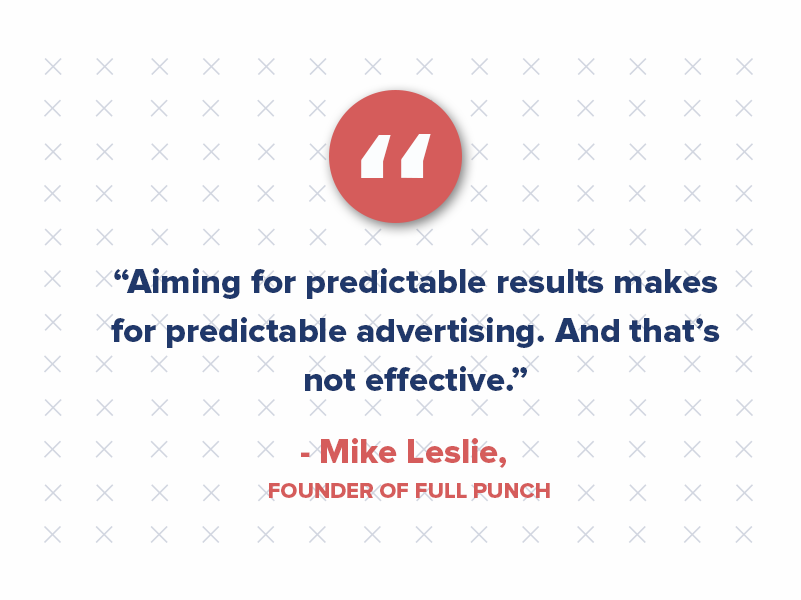
The desire for predictability can lead brands to rely on data and past performance to the point of stifling creativity and innovation. While predictive tools analyze everything from location to preferences, purchases, and search history, they ultimately fail to account for the messiness of human behavior. They can’t account for the emotional and personal factors influencing renter behavior.
Advertising has never been an exact science, nor should it aim to be. The idea that past consumer actions can reliably predict future behavior is flawed, and companies relying too heavily on predictive analytics will likely experience diminishing returns. Past performance does not predict future results. The repetition of predictable tactics inevitably leads to stagnation.
While data can provide insights, the art of advertising lies in its ability to engage, surprise, and break through the ordinary. It’s not about being predictable but about showing up in unexpected places and finding the human connection that resonates with people on a deeper level. Effective advertising is about understanding human behavior — not just the data sets it generates — and creating campaigns that reflect society’s complex, ever-changing nature.
Brands that rely solely on predictive ads risk becoming part of the ignorable 85% of ads that go unnoticed. By rejecting the predictable and embracing creativity, companies can produce advertising that stands out, breaks norms, and becomes part of the cultural conversation.
“We invested in a campaign aimed at prospective renters based on data analytics, but the audience we reached often didn’t align with our ideal tenant profile,” said Justin Landis, founder of The Justin Landis Group. “Many of the leads we received were unqualified, leading to a low conversion rate and wasted marketing dollars. We also faced challenges with the technology itself. The predictive models sometimes failed to account for local market nuances, resulting in ads that felt generic and disconnected from our community’s needs. This misalignment made the campaign feel less personal, and potential renters often overlooked our offerings.”
“The negative experience was frustrating, as we had high hopes for improving our lead generation,” Landis continued. “To pivot, we shifted our focus from purely data-driven advertising to a more integrated approach that included community engagement and personalized messaging. We began leveraging social media to connect with potential renters directly and gather feedback.” This approach enhanced the brand image of The Justin Landis Group. It allowed the company to tailor its offerings to meet audience needs better, ultimately leading to more successful marketing outcomes.
In the multifamily space, where renters’ needs and expectations evolve quickly, it’s essential to stay agile. Predictive ads, with their focus on past data, can leave marketers blind to new opportunities or shifts in renter behavior. Instead of leaning on predictive analytics, focusing on live data, real-time updates, and human-driven insights will allow brands to remain relevant and adaptable in a constantly changing market.
“We learned the hard way that keeping up with what residents want is crucial,” said Nick Stoddard, CEO at KC Property Connection. “We once ran ads aimed at young professionals, but it flopped because we didn’t consider families looking for bigger homes. After tweaking our approach to include families, we saw a big jump in leads and a 15% increase in occupancy rates. This experience taught us that regularly updating our marketing strategies is key to staying on top of changing resident needs.”
The Human Element: Why Predictive Ads Miss the Mark
While artificial intelligence (AI) is growing in digital marketing, its use in long-form content and predictive advertising isn’t without challenges. AI tools used in predictive analytics often simplify complex behaviors into data points, missing out on the nuances of human decision-making.
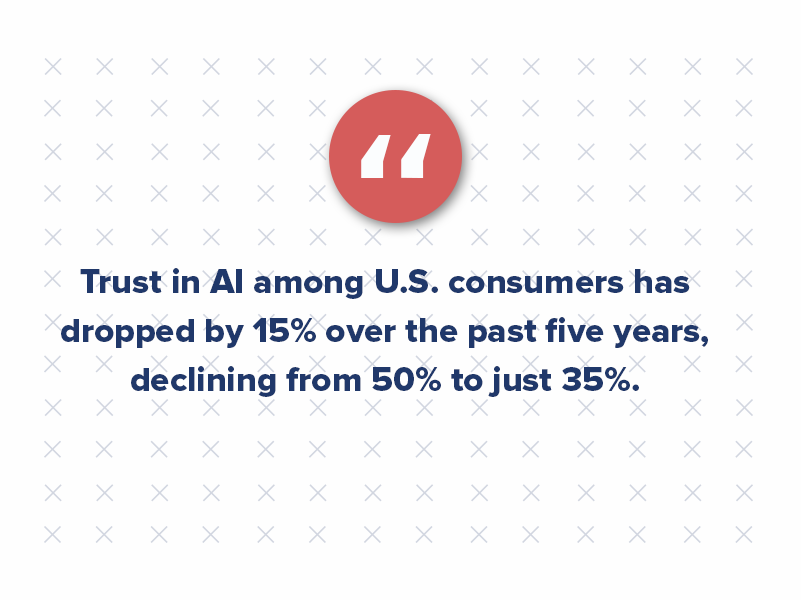
AI-driven predictive ads are not always effective in capturing the attention of renters seeking personalized experiences. Renters prefer authentic and relevant brands, which AI-driven, predictive models often struggle to achieve. Psychology Today reported that 70% of consumers spend more with authentic brands.
“The overreliance on AI in predictive advertising presents a challenge for us,” said Ryan Whitcher, founder and CEO of Harmony Home Buyers. “We initially embraced AI for our ad campaigns but soon realized it led to biased targeting and a 30% drop in qualified leads over three months. To address this, we implemented a hybrid approach, combining AI with human oversight, resulting in a 25% increase in qualified leads within two months and teaching us the importance of balancing technology with human expertise in our marketing strategies.”
Although 77% of advertisers have a favorable opinion of AI, consumer sentiment tells a different story. A 2024 report from the Edelman Trust Institute revealed that trust in AI among U.S. consumers has dropped by 15% over the past five years, declining from 50% to just 35%.
Also, a recent Neil Patel study found that content marketing incorporating personalization and emotional engagement outperforms data-driven, predictive ad strategies by 94.12%. Renters want to feel connected to the brand they’re considering, and predictive ads often fail to create that connection.
At Criterion.B, we prioritize building trust and emotional engagement through tailored content, real-time updates, and personal interactions. This approach builds lasting relationships, which is something predictive ads can’t do.
Why We Don’t Offer Predictive Ads
At Criterion.B, we’ve done our research. While predictive advertising may have its place in certain industries, the multifamily market demands a more dynamic, real-time approach. The unpredictable nature of renter behavior — combined with the increasing need for transparency and trust — means that predictive ads often fall short.
Rather than relying on speculative technology, we focus on proven methods: real-time pricing, availability updates, tailored content, and building genuine connections with renters. This approach doesn’t just drive traffic — it builds relationships. So while the allure of predictive ads is tempting, we’re committed to more personable (and reliable) strategies.

Proven Marketing Strategies From Industry Leaders You Can Start Using Today
Marketing can sometimes feel like a game of trial and error, but a few tactics consistently hit the mark.
We’ve chatted with 16 industry pros who’ve nailed down the strategies that work, from the power of cause marketing to the smart use of content repurposing.
Here’s a look at the marketing tactics these experts can’t live without — and why they’re so effective.

1. Champion Cause Marketing
One marketing strategy example that has shown immense success is cause marketing. Patrick Beltran, Marketing Director at Ardoz Digital, explains that this approach involves partnering with nonprofit organizations and charities to support meaningful causes. By aligning your multifamily brand with a cause, you add a human element to your marketing efforts, significantly boosting consumer perception and engagement.
“Consumers genuinely feel good about their purchases when they know their money is helping provide essentials like shelter, food, or other support to those in need,” says Beltran. The key to success with cause marketing is choosing a cause you are passionate about, as this authenticity drives better results for your campaigns.
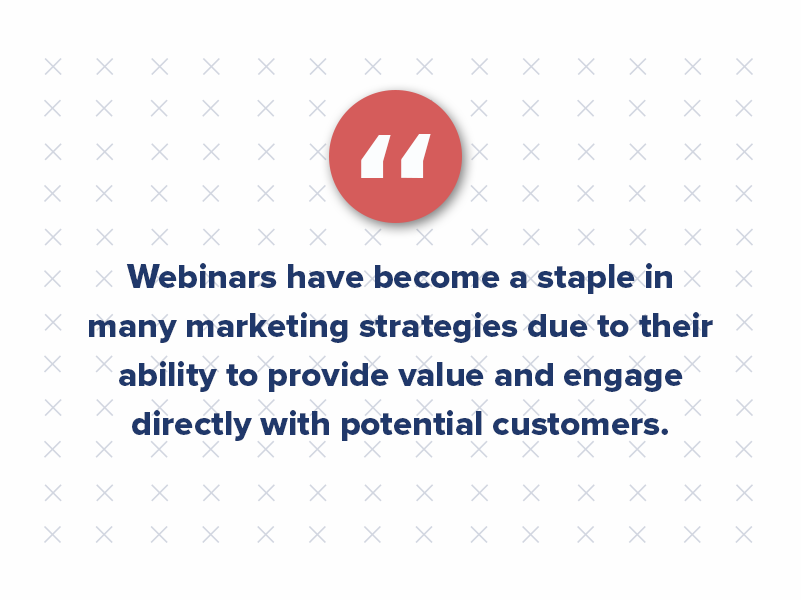
2. Host Value-Packed Webinars
Webinars have become a staple in many marketing strategies due to their ability to provide value and engage directly with potential customers. Rohit Vedantwar, Co-founder and Director at Supramind.com, highlights the effectiveness of this tactic by sharing how his team’s webinars led to a 45% increase in qualified leads and a 30% rise in product trials within six weeks.
“Webinars position our brand as a thought leader while fostering a sense of trust and authority with our audience,” says Vedantwar. By offering actionable insights and detailed product demos, webinars attract participants and drive conversions by addressing the specific needs of your audience.
3. Segment Newsletters by Interest
Personalization in marketing is crucial, and one way to achieve this is by segmenting newsletters based on subscriber interests. Meaghan Maybee, Marketing Communications Specialist at pc/nametag, shares how her team’s segmented newsletters have led to higher open rates, click-through rates, and lower unsubscribe rates.
“Our marketing team creates multiple newsletter types according to a subscriber’s unique interests,” says Maybee. This approach ensures that the content delivered is relevant to where the subscriber is in their buyer’s journey, making them more likely to engage with the emails and ultimately convert.
4. Nurture Leads with Email Campaigns
Email marketing remains one of the most effective ways to nurture leads and build relationships with potential customers. Randy Speckman, CEO at Randy Speckman Design, swears by nurturing email campaigns, sharing how a seven-email drip campaign for an online course launch significantly increased sales on launch day.
“Email nurturing works because it builds familiarity and trust over time,” says Speckman. The key to success with email marketing campaigns is providing real value in each message, which helps establish your brand as an authority in your field and encourages recipients to take action when the time is right.
5. Present at Industry Events
Industry events offer a unique opportunity to showcase your expertise and connect with potential clients face-to-face. Nicole Farber, CEO of ENX2 Legal Marketing, shares how presenting at law schools and marketing conferences has led to multiple new clients and substantial new business.
“Presenting in front of audiences allows me to showcase my knowledge and expertise,” says Farber. By establishing yourself as a thought leader and providing valuable insights, you can generate leads and build credibility in your industry.
6. Create In-Depth Content Guides
Content marketing is a powerful tool for establishing your brand’s authority and driving qualified leads. Josh Cremer, CEO and Creative Director at Redfox Visual, shares how an in-depth guide on local SEO best practices significantly increased qualified leads for his agency.
“Content works because it establishes your expertise, builds trust, and provides value to readers,” says Cremer. In-depth content guides address key concerns and questions that your audience may have, positioning your brand as a go-to resource in your industry.
7. Optimize Paid Social Media Ads
Paid social media advertising allows you to reach your target audience with precision and scale your marketing efforts. Jeff McGeary, Founder & CEO, PracticeVIP LLC, shares how paid social media ads have driven substantial new revenue for his clients.
“For small practices especially, paid social advertising is a game-changer,” says McGeary. By targeting your ideal customers and crafting relatable messaging, you can generate high-quality leads and achieve a significant return on investment.
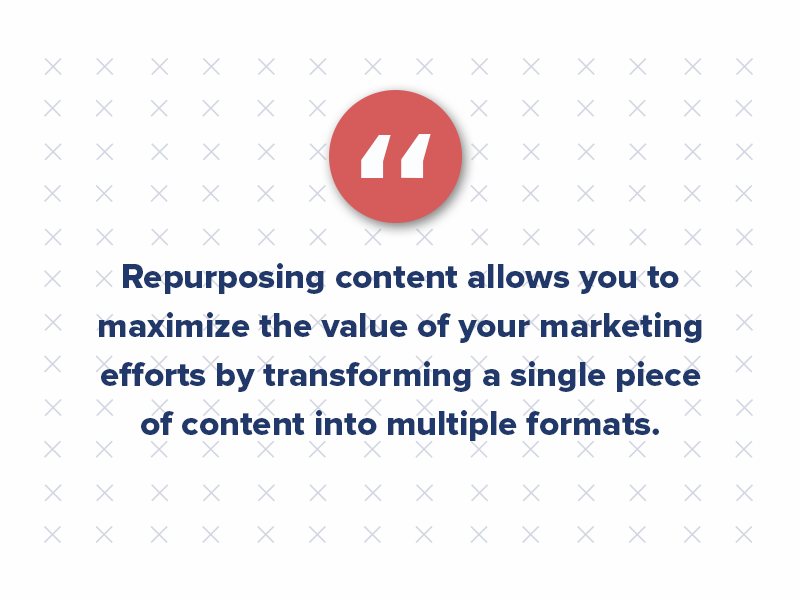
8. Maximize Reach with Content Repurposing
Repurposing content allows you to maximize the value of your marketing efforts by transforming a single piece of content into multiple formats. Vaibhav Kakkar, CEO of Digital Web Solutions, highlights how his team’s content repurposing strategy led to increased reach and engagement.
“We maximize the value of our content by transforming a single piece into multiple formats,” says Kakkar. This approach ensures that your core message reaches different audience segments, making your marketing strategies more efficient and impactful.
9. Personalize Your Email Marketing Campaigns
Personalization is key to effective email campaigns. Lauren Gast, Marketing Director at Truck Driver Institute, shares how personalized email campaigns have increased inquiries for their CDL training programs.
“It works because it creates a one-to-one and relevant relationship with the audience,” says Gast. By addressing the specific needs and interests of your audience, personalized emails can significantly boost engagement and conversion rates.
10. Showcase Customer Testimonials
Customer testimonials and case studies are powerful tools for building trust and credibility with potential clients. Tim Woda, Founder at White Peak, shares how leveraging customer testimonials led to an increase in leads and inquiries.
“Real-life success stories resonate with prospects far more than generic marketing messages,” says Woda. By showcasing the tangible benefits of your services through customer testimonials, you can convert leads into customers more effectively.
11. Produce Engaging Explainer Videos
Visual content, especially videos, is a highly effective way to communicate complex messages quickly and engagingly. Kevin Watts, President and Founder at Raincross, shares how an explainer video increased qualified leads by over 30% within the first month.
“Videos work because they can convey a complex message in a short, easy-to-understand format,” says Watts. Engaging visual content can capture the attention of your audience and drive them to take action.
12. Leverage Strategic Partnerships
Strategic partnerships allow you to tap into an established network and community, providing access to high-quality leads. Robert P. Dickey, President and CEO at AQ Marketing, shares how strategic partnerships have driven significant lead generation for his clients.
“Strategic partnerships work because you’re leveraging an established network and community that already trusts your partner,” says Dickey. By creating mutually beneficial partnerships, you can gain exposure to new audiences and drive organic growth.
13. Utilize User-Generated Content
User-generated content (UGC) adds authenticity to your marketing tactics by showcasing real customer experiences. Kam Talebi, CEO of Gigli, shares how utilizing UGC has improved their ROI and strengthened connections with customers.
“UGC is more effective than brand-generated content because it showcases the experiences that other people are having with our products,” says Talebi. Incorporating UGC into your marketing strategy can build trust and engagement with your audience.
14. Organize Industry-Specific Events
Industry-specific events directly engage your target market, making them a highly effective marketing tactic. Amar Ghose, CEO of ZenMaid, shares how organizing the “Maid Summit” significantly boosted brand awareness and generated high-quality leads.
“By bringing people together and providing valuable content, we not only increased our brand visibility but also maintained a steady flow of leads,” says Ghose. Organizing events allows you to connect with your audience on a personal level and establish your brand as a leader in your industry.
15. Tailor Marketing to Generational Segments
Understanding the unique preferences of different generational segments is crucial for crafting personalized marketing strategies. Farnam Elyasof, Founder of Flex Suits, shares how tailoring campaigns to Millennials and Gen X has optimized engagement and boosted leads.
“Being aware of generational nuances ensures that you are using the right marketing strategies to boost your leads and revenue,” says Elyasof. By addressing the specific needs and preferences of each generation, you can create more effective and relevant campaigns.
16. Offer Referral Incentives
Referral incentives are a cost-effective way to amplify word-of-mouth marketing and drive organic growth. John Cammidge, Handyman at Handyman John, shares how offering a 10% discount for referrals significantly boosted revenue and client loyalty.
“Referral incentives leverage trust — clients trust their friends’ recommendations,” says Cammidge. By rewarding existing clients for referring new customers, you can create a cycle of consistent growth and client retention.
Championing Success Through Strategic Marketing Tactics
These marketing tactics, championed by industry thought leaders, demonstrate the power of strategic, personalized, and value-driven approaches. Whether through cause marketing, personalized email campaigns, or organizing industry events, these marketing strategy examples have proven their effectiveness in driving results across various sectors. With these marketing tactics, you can enhance engagement, build trust, and achieve long-term success for your organization.

